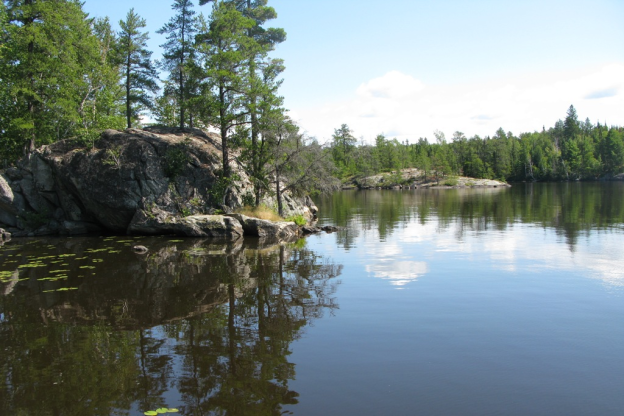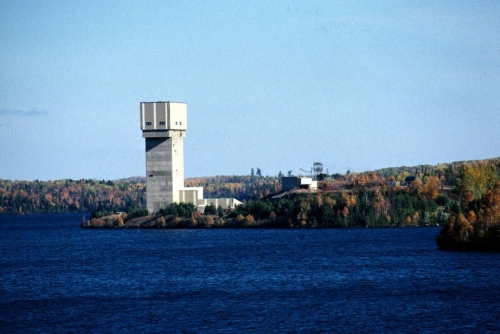
Mommy, what’s that noise I hear in the ground?
It’s just mining explosions, dear, go back to sleep
In the April 2013 press release by Duluth Metals, referred to here earlier, DM prez Vern Baker waxed eloquent about the shallow metal deposits just begging to be mined:
“We are pleased with the assay results which confirm the existence of mineralization at shallow depths between the Maturi Deposit and the Birch Lake Deposit.” stated Vern Baker, President of Duluth Metals. “These results show an opportunity to enhance the economics of the project by increasing production rates in the mining plan.”
Well, Vern, where is this exactly? Thoughtfully a map was provided:

Maturi West Exploration Target
You can see a larger copy of the map here.
The Maturi West Exploration Target sits right on top of the Birch Lake campground. You can see Little Lake Road and Campground Road (leading to the campsites also shown on the map) in the lower center of the map.
Returning to the Duluth Metals press release, here are the results of three bore samples shown on the map:
MSW-0014 returned a 150 foot intersection of 0.81% copper, 0.27% nickel, 2.7 g/t silver and 1.00 grams TPM (TPM = Platinum+Palladium+Gold) at a 0.3% Cu cut-off including a 110 foot intersection of 0.94% copper, 0.31% nickel, 3.1 g/t silver and 1.17 grams TPM at a 0.5% Cu cut-off;
MSW-0017 returned a 210.5 foot intersection of 0.64% copper, 0.24% nickel, 2.1 g/t silver and 0.35 grams TPM at a 0.3% Cu cut-off including a 120.5 foot intersection of 0.72% copper, 0.24% nickel, 2.6 g/t silver and 0.44 grams TPM at a 0.5% Cu cut-off; and
MSW-0018 returned a 83 foot intersection of 0.60% copper, 0.19% nickel, 2.1 g/t silver and 0.41 grams TPM at a 0.3% Cu cut-off including a 50 foot intersection of 0.90% copper, 0.28% nickel, 3.7 g/t silver and 0.51 grams TPM at a 0.5% Cu cut-off.
Let us assume, arguendo, that Vern and Duluth Metals aren’t just blowing smoke up potential investors’ asses, and that they really mean to get at this ore. How are they going to do it?
When I suggested the other day that an open pit mine might be in the offing or in the future, the pro-mining trolls at the Friends of the Boundary Waters Facebook page said it was ridiculous. So what about an underground mine? Huh? Well, what about it?
An underground mine just beneath the surface in this area invites the Shebandowan Scenario. Here are some quotations from part of the Minnesota Environmental Quality Board’s comprehensive copper/nickel study from the late 70s:
MEQB – Vol 3 – CH1 Geology and Mineralogy
Stevenson, Kreisman, Sather (TN443.M6M56xv.3ch1)Page 50. Regarding faults in the study area: “Cooper concluded that the entire area underlain by the Duluth Complex is extensively faulted and that this faulting may have played an important role in the localization of the copper nickel sulfide mineralization. Faults and joints contribute to the permeability of the bedrock for water movement.”
MEQB – Vol 3- CH2 Geology and Mineralogy
Stevenson, Kreisman, Sather (TN443.M6M56x v.3 ch2)Table 2 – Indicates in resource zone 1 (INCO, Nearest BWCA) upper 1/2 (0-1000 ft) of the Cu/Ni resource is 0.5% copper. Below 1000’ is 0.5% Cu.
In resource zone 2 most of the resource is below 1000‘ but quantities around 0.5% exist) to 0-1000’.Page 21-22. Surface subsidence concerns under Birch Lake exist if mine is closer than 1000’ from the surface.
Regarding under lake mining: In addition if a high density fracture zone is encountered in such a situation not only would the possibility of subsidence increase, but water infiltration from the overlying lake on the surface and ground water system could greatly exceed estimates or data available to date. This water may be of poor quality and result in acute discharge problems. Just such an occurrence posed serious problems at INCO’s Shebandowan in Canada where nickel is being mined from beneath a lake.
If you look at a topographical map of the area, you can see how the bedrock might be shot through with faults. Incidentally, these citations to the copper nickel study are not online, at least as far as I can find, but you can read the executive summary here.
Lake Shebandowan is in northwest Ontario, not far from Thunder Bay. Here, just for fun, is a photo of a mine shaft tower at Lake Shebandowan for the INCO mine; I call it the Shebandowan Ness monster:

Maybe we should hope that Vern and Duluth Metals are just blowing smoke.
Thanks for your feedback. If we like what you have to say, it may appear in a future post of reader reactions.


